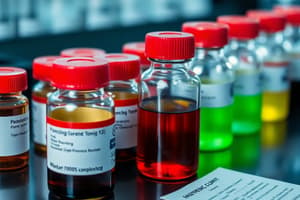Podcast
Questions and Answers
What is the primary purpose of a forensic toxicologist?
What is the primary purpose of a forensic toxicologist?
- To treat patients who have been exposed to toxins.
- To develop new medications to counteract the effects of poisons.
- To analyze evidence to determine if toxins or drugs are present. (correct)
- To determine the psychological effects of toxins.
Which of the following best describes the process of 'metabolism' in the context of toxicology?
Which of the following best describes the process of 'metabolism' in the context of toxicology?
- The process by which a substance enters the body.
- The process by which a substance is transported throughout the body.
- The process of removing a substance completely from the body.
- The process by which a substance is broken down by the body, often producing metabolites. (correct)
Which organ is primarily responsible for processing and detoxifying substances in the body?
Which organ is primarily responsible for processing and detoxifying substances in the body?
- Liver (correct)
- Kidney
- Lungs
- Intestines
What is the primary mechanism by which cyanide causes harm in the body?
What is the primary mechanism by which cyanide causes harm in the body?
Which substance, known for its extreme potency, can significantly impair respiratory function, leading to accidental overdoses and fatalities?
Which substance, known for its extreme potency, can significantly impair respiratory function, leading to accidental overdoses and fatalities?
What is the primary reason that arsenic was a well-known poison in the early 17th century?
What is the primary reason that arsenic was a well-known poison in the early 17th century?
A patient presents with symptoms including muscle paralysis, difficulty breathing, and decreased heart function; which substance is most likely responsible?
A patient presents with symptoms including muscle paralysis, difficulty breathing, and decreased heart function; which substance is most likely responsible?
Which of these does NOT typically manifest in cases of heavy metal poisoning?
Which of these does NOT typically manifest in cases of heavy metal poisoning?
Which of the following is a potential symptom of exposure to the pesticide Aldrin?
Which of the following is a potential symptom of exposure to the pesticide Aldrin?
A patient exhibiting a blue discoloration along the gum line, accompanied by nausea and abdominal pain, likely suffers from exposure to which toxic substance?
A patient exhibiting a blue discoloration along the gum line, accompanied by nausea and abdominal pain, likely suffers from exposure to which toxic substance?
When an individual requires consistently higher doses of a substance to achieve the same initial effect, which of the following is applicable?
When an individual requires consistently higher doses of a substance to achieve the same initial effect, which of the following is applicable?
Which schedule of the Controlled Substances Act includes drugs with a high potential for abuse and no accepted medical use?
Which schedule of the Controlled Substances Act includes drugs with a high potential for abuse and no accepted medical use?
Which of the following best describes the primary effect of narcotics on the central nervous system?
Which of the following best describes the primary effect of narcotics on the central nervous system?
What is a common side effect associated with the use of stimulant drugs?
What is a common side effect associated with the use of stimulant drugs?
Which test is specifically used to identify the presence of hallucinogens?
Which test is specifically used to identify the presence of hallucinogens?
Flashcards
Toxicology
Toxicology
The study of drugs, poisons, and toxins, including their effects and how the body processes them.
Toxins
Toxins
Naturally occurring poisonous substances produced by living organisms.
Poisons
Poisons
Manufactured or natural chemicals that can cause serious harm to the body.
Absorption
Absorption
Signup and view all the flashcards
Metabolism
Metabolism
Signup and view all the flashcards
Dosage
Dosage
Signup and view all the flashcards
Potency
Potency
Signup and view all the flashcards
Nature of Exposure
Nature of Exposure
Signup and view all the flashcards
Toxic Metabolites
Toxic Metabolites
Signup and view all the flashcards
Addiction
Addiction
Signup and view all the flashcards
Illicit Drugs
Illicit Drugs
Signup and view all the flashcards
Controlled Substances
Controlled Substances
Signup and view all the flashcards
Hallucinogens
Hallucinogens
Signup and view all the flashcards
Narcotics
Narcotics
Signup and view all the flashcards
Stimulants
Stimulants
Signup and view all the flashcards
Study Notes
Forensic Toxicology and Pharmacology
- Forensic Toxicologists analyze evidence to identify toxins and drugs.
- Toxicology studies drugs, poisons, toxins, and metabolites (byproducts of drug breakdown in the body).
- Poisons are natural or manufactured chemicals that can cause serious harm. Examples include arsenic and rat poison.
- Toxins are poisonous substances produced by living organisms.
- Toxicologists use specific tests and technologies to identify harmful substances.
- Body fluids, stomach contents, and fluids from inside the eye, are examined in deceased individuals. Liver and kidney samples are tested when the person is deceased.
History of Forensic Toxicology
- Paracelsus stated, "All substances are poisons; the right dose differentiates a poison and a remedy."
- Socrates was an early documented victim of poisoning.
- In 1600, arsenic was used as a deadly poison.
- In the 1800s, Mathieu Orfila and Robert Christison developed chemical analysis methods to detect arsenic in tissues.
- In 1918, Charles Norris and Alexander Gettler standardized techniques and testing in a toxicology lab to determine cause of death.
Science of Toxicology - ADME
- Absorption: Toxins enter the body through the digestive tract, lungs, skin or bloodstream.
- Distribution: Toxins are carried by the circulatory system to various organs like the brain, liver and kidneys.
- Metabolism: Toxins are broken down into metabolites. The liver plays a major role in processing ingested toxins.
- Excretion: Removal of toxins from the body through urine, feces, sweat or breath.
How Toxins and Drugs Affect the Body
- Acetaminophen destroys cells and impairs the liver's ability to detoxify substances.
- Cyanide binds to hemoglobin preventing oxygen use, leading to loss of consciousness and death.
- Fentanyl is highly potent, affecting breathing control; often a cause of accidental overdoses.
- Botulinum toxin (Botox) causes paralysis of muscles, affecting breathing and potentially causing death.
- Cocaine increases blood pressure and can cause heart attack, stroke and death.
- Five main types of drugs are stimulants, narcotics, depressants, hallucinogens, and anabolic steroids.
- Dosage and potency affect toxicity severity.
Toxicity Factors
- Dosage is the amount of a toxin or drug taken.
- Potency is the strength of a toxin or drug that can be lethal in small amounts.
Nature of Exposure
- Toxins and drugs can be ingested, inhaled, injected, or absorbed through the skin.
- Toxic metabolites can be produced from non-toxic substances; for example, methanol can produce toxic formic acid, leading to blindness and death in small quantities.
- Indicators of poisoning are death with no injury, sudden unexplained death, unexplained recurring illnesses, and similar symptoms in numerous people at the same time.
Drug Addiction, Withdrawal, and Dependency
- Addiction involves the body developing a physiological need for a drug, characterized by sensations of pleasure when the drug is consumed.
- Withdrawal involves negative physical and psychological symptoms arising from discontinuing a drug.
- Dependency is characterized by an intense craving for a drug, without the same withdrawal symptoms associated with addiction.
Characteristics of Poisons, Toxins, and Drugs
- Heavy metals (e.g., arsenic) may enter the body via ingestion, inhalation, or skin absorption. They are stored in soft tissues and can damage organs.
- Arsenic exposure can cause gastrointestinal symptoms, difficulty speaking, muscle cramps, convulsions, kidney failure, and death, among other symptoms).
- Mercury, lead, potassium chloride, and sodium pentothal have specific effects on the body.
- Pesticides and herbicides (e.g., Aldrin and Dieldrin) can cause anxiety, seizures, rapid heartbeat, muscle weakness, etc.
- Glyphosate can cause gastrointestinal problems, skin and eye irritation, and kidney malfunction .
Processing Evidence
- Drug-related evidence (e.g., pills, powders) must be collected and documented as soon as possible. Evidence is processed by trained dogs to detect the presence of drugs and chemicals. People paying others to smuggle drugs are called mules.
Evidence Packaging and Forensic Analysis
- Evidence must be packaged and labeled properly to prevent contamination.
- Preliminary toxicology tests can involve color changes to indicate the presence of drugs.
- Confirmatory tests (e.g., chromatography, mass spectrometry) are multi-step processes that identify and measure specific drugs.
Methods of Analysis
- Thin-layer chromatography separates compounds based on chemical properties and affinity.
- Gas chromatography identifies and separates drug components.
- Mass spectrometry analyzes molecules to identify and quantify components.
- Liquid chromatography and mass spectrometry identify and quantify low levels of drugs in blood samples.
- Tests are developed to detect poisoning exposure (e.g., cyanide, chronic poisoning; Mercury, Lead poisoning).
Chemical Testing
- Duquenois-Levine test identifies cannabinoids (e.g., THC) in plant matter.
- Other analyses may include polypharmacy (mixture of drugs), cyanomethemoglobin (potential cyanide poisoning), carboxyhemoglobin (potential carbon monoxide poisoning), thermolabile (substance breaking down at elevated temperatures) and ICP-MS (detect inorganic materials or metals).
Toxicology/Pharmacokinetics vs. Toxicology/Pharmacogenetics
- Pharmacokinetics describes how the body handles drugs/toxins (absorption, distribution, metabolism, and excretion).
- Pharmacogenetics considers how genes affect individual responses to drugs/toxins.
Types of Drugs and Substances
- Cutting agents are added to illicit drugs to lower their concentration.
- Alkaloids are substances produced by plants and some animals; examples include morphine and codeine.
- Mescaline is a hallucinogenic drug found in cacti.
- Psilocybin is found in psilocybin mushrooms, a hallucinogenic drug.
- Clandestine drug laboratories manufacture controlled substances without government authorization.
- LD50 is the lethal dose required to kill half the population.
- Designer drugs are synthesized drugs that are designed for abuse and to avoid current drug laws.
Controlled Substances
- Scheduled Drugs are legally permissible drugs that have restrictions on the sales, possession, and use of certain drugs. Several schedules exist, in which Schedule I drugs have the highest potential for abuse with no medical use.
Studying That Suits You
Use AI to generate personalized quizzes and flashcards to suit your learning preferences.




